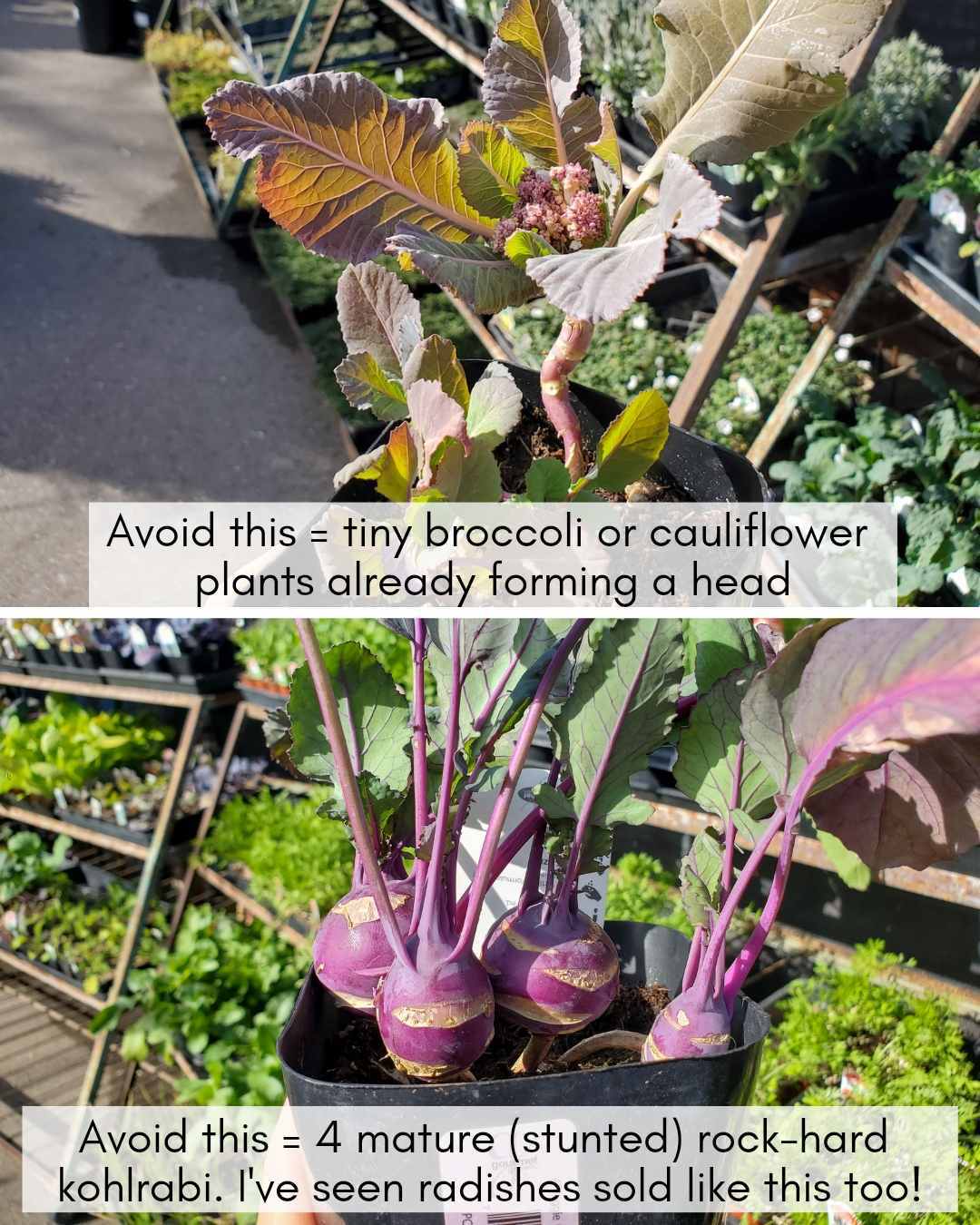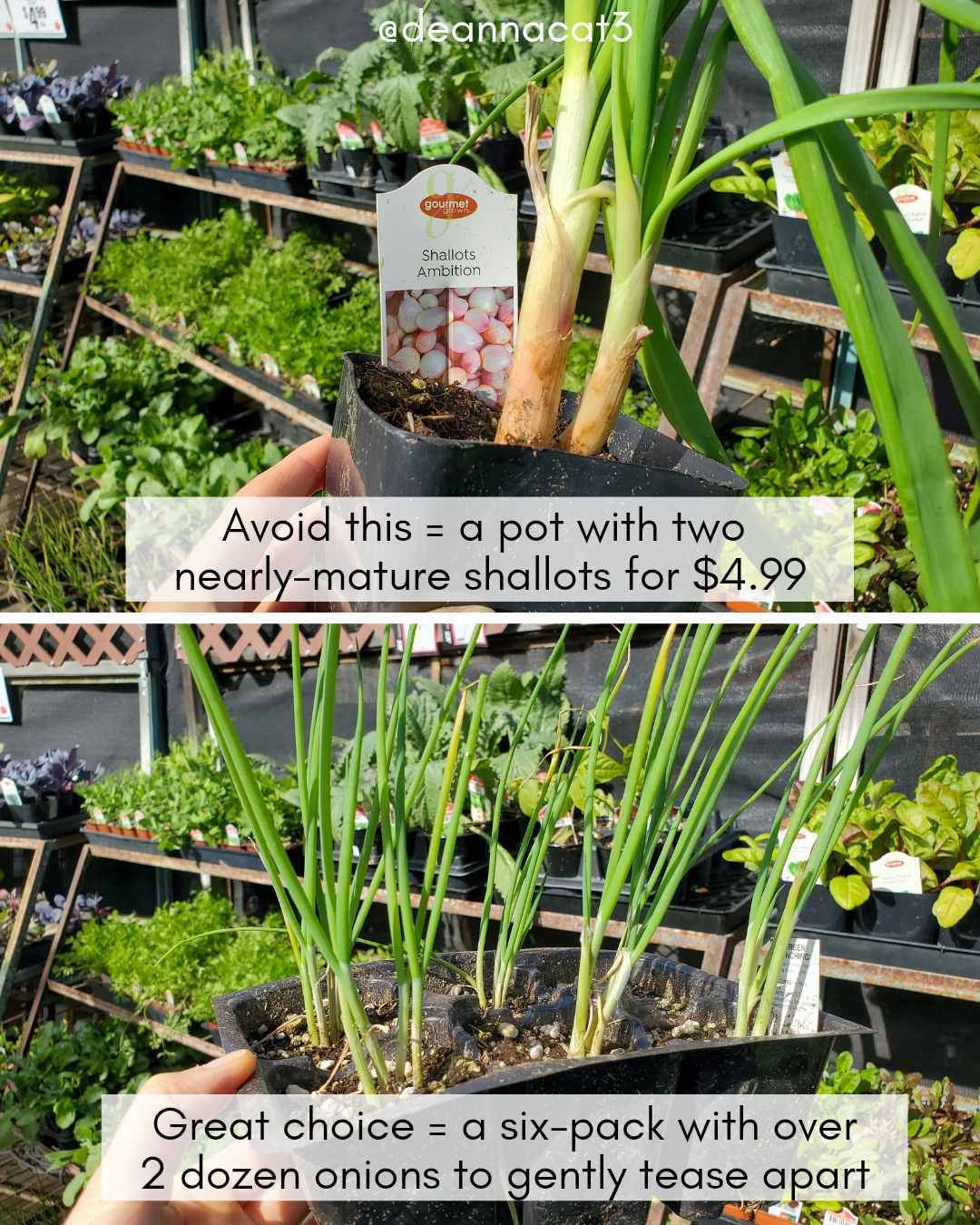How to Choose the Best Seedlings at the Nursery
There’s no shame in buying nursery seedlings or “starts” instead of (or in addition to) growing food from seed! Yet there are some pretty pitiful seedlings out there sometimes… so much so, it actually makes me mad. So let’s talk about how to choose the most healthy nursery seedlings for your garden, including tips and examples of seedlings to avoid.
When nurseries sell bolted, stunted, root-bound, diseased, or otherwise crummy seedlings, it sets folks up for frustration and failure. New gardeners may plant them, feel like they did something wrong, avoid that crop next time, or even worse, want to give up gardening altogether! I hope these tips and examples help prevent some of that.
Where to Buy Seedlings
Try to seek out small local nurseries if possible. Even better, become a regular! We love our Miner’s Ace Hardware garden center, locally-owned Farm Supply, and another small mom-and-pop by the name of Cherry Lane Nursery here on the Central Coast. Shopping locally is awesome, period, but especially when it comes to plants! Smaller, local places are more likely to carry things that are best suited to grow well in your area, and are currently in season. They’ll probably have more unique varieties of seedlings to choose from as well.
Most big box stores will just stock whatever is standard across all their stores, regardless of the season. For example, I frequently see tomatoes and peppers out for sale at Home Depot in January. That is not the time of year to start these crops in most places in the US, here included. Big box stores are also more likely to use chemical fertilizers or pesticides and have fewer organic options.

Seedlings vs Direct Sowing
Keep in mind that some veggies grow best when direct sowed (e.g. plant seeds outside where the plants will stay and grow for the season), instead of being started in containers and transplanted – whether you start them or the nursery does!
Most root veggies don’t like to be transplanted, including carrots, radishes, beets and turnips (though we’ve had success transplanting beets). Peas and beans also thrive when directly-sown. Plus, you can get hundreds of seeds for the same price! Therefore, focus on buying other types of seedlings like tomatoes, peppers, leafy greens, herbs, broccoli, onions, eggplant and flowers instead.
Picking the Healthiest Seedlings
Age and size
Bigger is NOT always better – especially in the seedling world. The best nursery seedlings are the ones that are the most tender, bright green, young, and healthy-looking, regardless of size! Short stocky seedlings are ideal. Avoid the tall, leggy, stretched out, woody, tough seedlings.
Large or overly-mature seedlings may be stressed and root-bound from being left in a small container for too long. Even after transplanting, they may be permanently stunted in your garden. Root bound seedlings are also far more likely to bolt (prematurely go to seed) rather than thrive and produce food – even if you do everything else “right”.


Looks for pests & disease
Be sure to thoroughly check nursery seedlings for pests, and avoid seedlings with clear signs of stress, discoloration, or disease. Sometimes we find aphids or cucumber beetles on nursery seedlings around here. Put those ones back. We don’t want to bring home and introduce any extra pests or diseases to the homestead! Plus, those plants are likely already stressed and less healthy, giving them a disadvantage from the start.


Crowded seedlings: free plants, or not?
If several seedlings are growing in a cluster, you may be able to gently tease them apart to separate them – and get free plants! However, some mature seedlings may get shocked if you disturb or tear their roots in the process. Plus, crowded seedlings often get stunted early on – and stay stunted compared to those that were properly thinned! Therefore, I suggest choosing containers with just 1 to 3 seedlings, not dozens crammed together.
One caveat is young onions and leeks. Those seedlings are perfect to tease apart, and do not get shocked or stunted!

Other Considerations When Buying Nursery Seedlings
Consider the season
Choose seedlings that are currently “in season” and ideal for transplanting right now in your area. For example, choose heat-loving crops like tomatoes, squash, eggplant and peppers if you’re coming up on your hot season and the risk of frost has passed. Cooler season crops include things like leafy greens, cabbage, root veggies, or broccoli.
If you aren’t sure when to plant what, it sounds like you need a garden planting calendar! Sign up to get your free Homestead and Chill garden planting calendar below. Available for every growing zone, the charts include info on when to start seeds indoors, direct sow seeds outside, or transplant seedlings (including nursery seedlings) for dozens of veggies.

Consider the variety
While shopping, if you’re trying to decide between varieties (e.g. two different types of broccoli) bust out your phone and do a quick google search. Read up on those varieties growing condition requirements – it may reveal info that’ll sway your decision one way or another! Because many varieties within the same family or type of plant have pretty different characteristics. Some have better heat or cold tolerance, longer or shorter days to maturation (time to harvest), or disease resistance.
For example, because we have fairly cool and foggy summers here, we can’t just grab up any old tomato seedlings. We need to search for smaller, early-ripening, cool weather tolerant types that perform here better than big beefy heirlooms. Additionally, we look for seedling varieties with natural resistance to powdery mildew – a common issue on this homestead.
Organic or not?
Buying certified organic seedlings is awesome, but isn’t necessarily a dealbreaker. If you follow organic gardening practices at home, the plants should grow up to be healthy and “safe” – regardless of their first few weeks of life. Exceptions include pollinator plants (e.g. milkweed) or plants you may consume immediately like lettuce. Choose organic and no-spray then! Yet organic agriculture operations, including seed farms and nurseries, are better for the environment, wildlife and farmworkers alike.

A final take-home message
Please, don’t buy something “just to buy something”. If the plant doesn’t look great, isn’t the variety you were hoping for, or doesn’t sound like a good match for your garden, don’t settle! Wait. Ask. Inquire to the nursery staff about their seedling delivery schedule. Maybe they are in for a large seedling shipment tomorrow! Shop around. Hit up another local spot. Furthermore, if you still can’t find what you want, see if your local nursery can put in a special request or order from their farmers for you! As a matter of fact, we do this all the time for our fruit trees and vines.
In all, if you are going to invest your time, energy, and love into raising plants, you might as well start with the best chances possible! And if you’re feeling up to it, consider growing some food from seed too. Learn more with our Seed Starting 101 guide.
I hope you feel more prepared and confident to choose stellar seedlings for your garden after reading this. Happy growing!
You may also like:
- Transplanting Seedlings Outside: Tips for Success
- How to Amend and Fertilize Garden Soil Between Seasons
- How to Build a Raised Garden Bed: Step by Step Tutorial








5 Comments
Robin Bell
Hi Deanna, Just to say thank you for another clear, focussed and extremely helpful article. You provide not only good sensible and timely advice but also give one courage! Keep it coming!
All the very best from the U.K.,
Robin
Aaron (Mr. DeannaCat)
Thank you so much Robin!
Shaylee Packer
I didn’t realize that bigger isn’t always better when buying seedlings. My son has decided that he would like us to plant a garden next year, and neither of us have experience with gardening. I will have to keep these tips in mind as it gets closer to planting season.
Taylor Anderson
Two of my friends really love plants, so getting them some as gifts may be a good idea. I like how you mentioned that bigger is not always better for seedlings, as they tend to be more healthy. These tips could help me buy some great plants, so thanks for sharing them.
Sheri Nugent
Hi Deanna – I feel like I should get college credit for my work based on your website. You are my garden guru – I’ve never gardened before – and now I have raised beds full of veg, companion flowers, and tons of bees and butterflies. I have a question that you may have experienced to:
I planted golden beets from starter plants a few months ago. Also in that raised bed is a serrano pepper plant. The pepper plant never produced peppers – so far – but its a very healthy plant so that’s fine, I guess.
The golden beets taste oddly spicy. Delicious – but unmistakably spicy/hot.
Is it possible that the beets picked up flavor from the serrano plant? Or am I delusional? It’s a 4 x 5 ft bed, beets around the edges, the serrano plant in the middle.
I wonder if you’ve ever experienced something like that.
Thanks!
Sheri